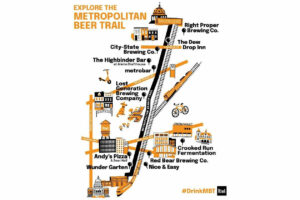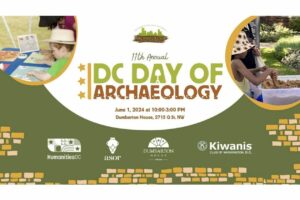Streets of Washington is the brilliant blog covering some of DC’s most interesting buildings and history written by John DeFerrari. John is also the author of the equally brilliant Lost Washington DC. ‘Streets of Washington Presents…’ will feature some fascinating buildings and history from around PoPville.
The monumental bank building on the southeast corner of 14th and G Streets, NW—vacant now for well over a decade—is one of several such landmarks in Washington’s old financial district, but it has lived the ups and downs of the banking industry much more dramatically than the others. It was born as the home of a feverish enterprise that burned itself out after only 20 years. After going on to host the venerable National Bank of Washington for many decades, it went dark when that institution also collapsed in 1990. For more than a decade now, plans have been afoot to turn it into a museum to commemorate the victims of the Armenian genocide of 1915-1923. The building, including its interior, is protected as an historic landmark. It’s one of only 13 properties in the District with an historic interior designation. As reassuring as it is that plans are in the works for the building’s future, it is also disheartening to see it stand vacant for so long—an unintended reminder, should we need one, of how impermanent our financial institutions can be, despite their best efforts to convince us otherwise.
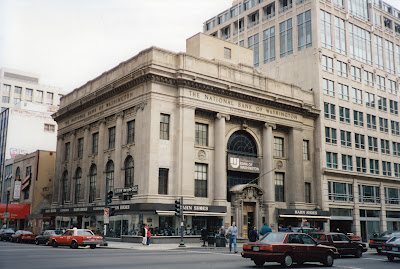
The bank building as it appeared in 1995 (Photo courtesy of the archives of the D.C. Preservation League).
Constructed in 1926, the building was originally the home of the Federal-American National Bank, which had been founded 13 years earlier. Its first and only president was John Poole (1875-1940), an extraordinary individual who once wielded enormous influence in the local financial world. Poole’s roots were humble; he was born to a Parkersburg, West Virginia, grocer who moved his family to Washington when John was only a month old. Young Poole was educated in DC public schools and began his professional career as a messenger for the United States Express Company. His talents apparently were recognized, and he quickly worked his way up through several DC financial institutions.
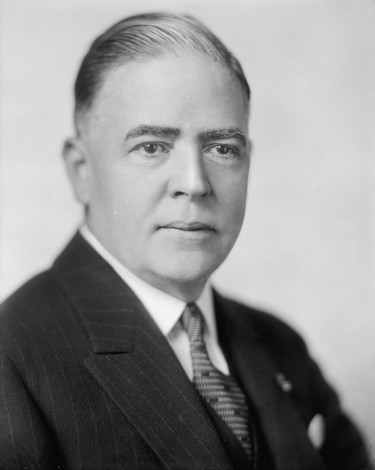
John Poole (Source: Library of Congress).
By 1912, Poole was 36 years old and at the top of his game as cashier of the Commercial National Bank. The Washington Post noted that Poole was “near the head of this city’s group of younger bankers.” It was an opportune time to be in the financial world; Washington’s banks had grown tremendously since the turn of the century, more than tripling their assets. Then in January 1913, Poole, who was also on the board of directors, led a group of 13 board members who decided to split off from the Commercial National and form their own bank. Their new Federal National Bank was an instant sensation, raising $1.5 million from investors within three days of being announced. It opened the doors of its fully-furnished banking room just two days after that. A throng of new customers deposited almost $500,000 on opening day.
Continues after the jump.
Within three months, the bank had bought the office building it was renting on the southeast corner of 14th and G Streets NW, where the White House stables had once been located. A Post article attributed the new bank’s extraordinary success to its daring innovations, such as opening early in the day (at 8:30am) and mailing monthly statements to account holders rather than requiring them to turn in their passbooks to have their account information updated. As the bank prospered, its charismatic leader also gained increasing fame. During World War I, Poole served as chairman of the five Liberty Loan campaigns held in Washington, raising substantial funds for the war effort. In 1922, his bank merged with the American National Bank to become Federal-American, one of the largest banks in the city.
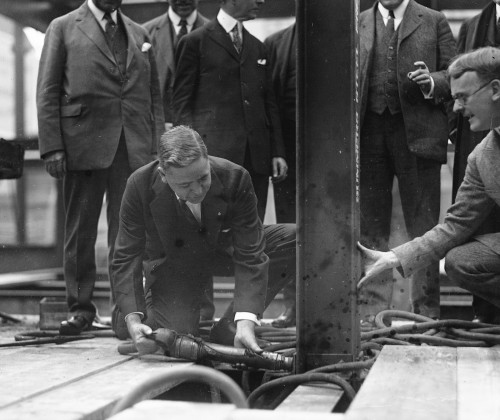
John Poole driving in the first rivet on the Federal-American bank building in 1924 (Source: Library of Congress).
Once the merger was complete, the new bank began planning for a grand headquarters building that would suitably convey its wealth and prestige. Alfred C. Bossom (1881-1965), a leading national designer of bank buildings, was chosen as chief architect, in consultation with Jules Henri de Sibour (1872-1938), a prominent Washington architect noted for his grand Beaux-Arts designs, such as the 1912 Riggs (Keith-Albee) building just a block to the west. Bossom’s elegant 4-story Neoclassical Revival design for the Federal-American, with the main banking room elevated to the second floor, created an extraordinarily powerful effect. The banking room loomed large and central to the design, a financial concourse of dramatic stature. The unusual placement of the banking room on the second floor also allowed the company to rent out space for retail shops at street level. The building was constructed by Washington developer Harry Wardman (1872-1938), known for the high quality of his work.
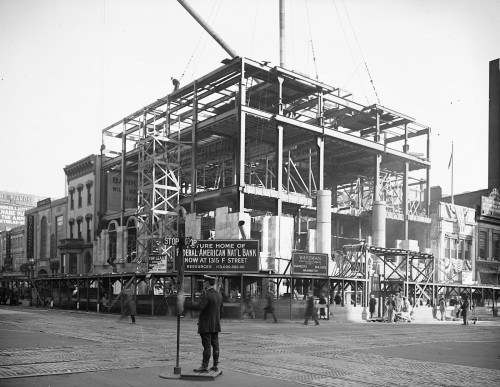
The bank under construction in 1925 (Source: Library of Congress).
When the new building opened in March 1926, it was universally admired as an “architectural gem, both within and without.” The spacious interior banking room was designed in a fetching Italian Renaissance style, with hand-carved Italian walnut counters contrasting with rough Aquia Creek sandstone on the rear wall to create something of a “Medieval” look. The high ceiling had ornate octagonal coffers hand-painted with Spanish designs. From it hung a massive Florentine iron chandelier, clad in an antique pewter finish, that contained 90 electric light bulbs.
Most remarkable of all the bank’s features were the new Clear Vision counters, patented by Poole and called “the greatest contribution to banking architecture in 100 years” by the press. The counters were designed to be very open, with only low grills in the middle, but it was still impossible for anyone to reach over them and try to take cash from the other side. They eliminated the iron-barred teller cages traditionally found in banks, allowing for better air circulation, better monitoring of both employees and customers, and friendlier customer interactions. As Poole predicted, his innovative counters became very popular and were soon imitated by other banks. Poole eventually took out patents on his design in 14 countries.
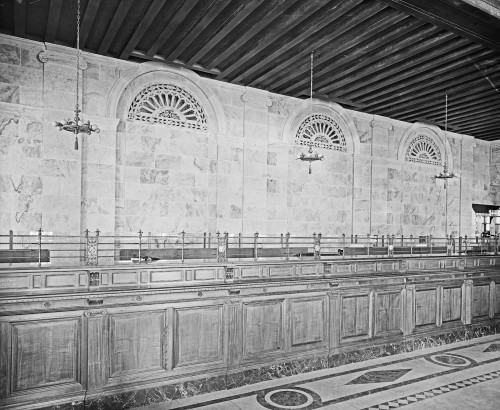
Poole’s Clear Vision banking counter (Source: Library of Congress).
It was common at the time to admire, as the Post did, the Federal-American’s youthful energy: “Although one of the younger large banks in the District, the Federal-American in the last few years has merited attention not only locally but also throughout the country as a progressive institution daring to throw off the shackles of custom and usage in the interest of improved methods and greater service.” In those days, no one worried that being brash and aggressive might get a bank in trouble if the economy ever turned sour.
As late as January 1933, the Federal-American Bank appeared to be prospering just as it always had, despite the onset of the Great Depression. A Post article from that time claimed that record levels of deposits were on hand. Further, Poole had just completed three years of service as a member of the Advisory Council to the Federal Reserve Board, and one would have thought his intimate knowledge of the industry would ensure that his bank was on a sound footing. However the Federal-American, like many others, was hit hard as panicky customers across the country began making large withdrawals. Finally in March 1933, as soon as he assumed office, President Franklin D. Roosevelt declared a “bank holiday,” closing all banks temporarily so that their finances could be assessed. FDR’s promise was that only those banks strong enough to stay in business would be allowed to reopen, and he urged Americans to put their money back in those banks. The strategy worked, and the crisis eased. However, the Federal-American—the hot new bank that was only 20 years old—was found to be insolvent and never allowed to reopen.
According to an analysis prepared for the National Register of Historic Places, the sumptuous banking palace at 14th and G played a significant role in the demise of the Federal-American. The bank had sunk so much into its building—almost 50 percent of its capital assets—that it didn’t have the flexibility to respond to the strains of the massive bank run in early 1933. The bank’s remaining assets, along with those of six other failed DC institutions, were combined to form a new Hamilton National Bank, which kept the old Federal-American building as its headquarters when it opened later that year.
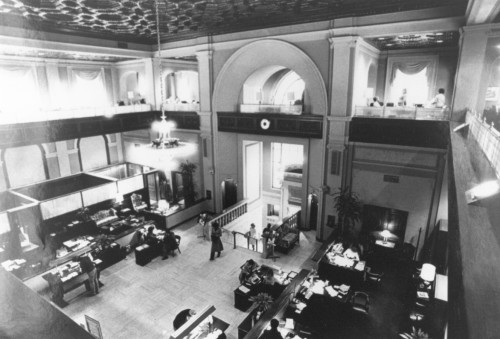
The banking room circa 1989 (Photo courtesy of the archives of the D.C. Preservation League).
Poole reportedly lost his home and all his savings when the bank collapsed, having confidently invested heavily in his own institution. He filed for personal bankruptcy in 1934. Still he managed to remain active in business as conservator of the failed bank’s assets and as a real estate and financial consultant. He died in 1940.
The Hamilton National Bank lasted until 1954, when it was absorbed by the National Bank of Washington. Recognizing the prestige of the beautiful Federal-American building, NBW moved its headquarters there from its previous landmark building at 7th Street and Pennsylvania Avenue. The new headquarters gained the NBW name in great bronze letters, along with the motto, “Washington’s Oldest Bank.”
In the late 1980s, the D.C. Preservation League began a successful campaign to have the beautiful building named an historic landmark. At the hearing held before the Historic Preservation Review Board in June 1990, NBW vice president David George testified that his company had no objection to the historic designation of either the interior or the exterior, although he noted that the bank intended to get rid of the ground floor retail tenants and use that space for its own banking needs. Further, the bank might want at a future date to build additional floors on top of the structure, as the building was designed to accommodate such future expansion. —But none of this really mattered. Less than two months later, the federal government seized control of NBW, declaring it insolvent, and sold its assets to the Riggs National Bank. Riggs declined to use the old building for any of its own operations, beginning its long period of dormancy.
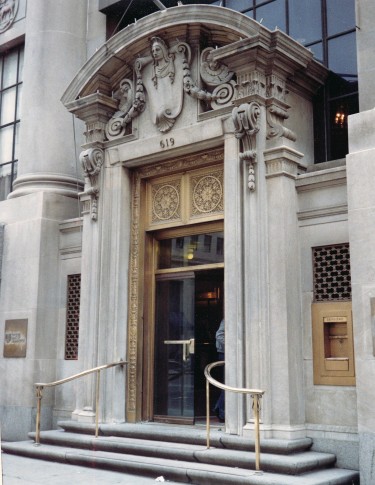
The main entrance (Photo courtesy of the archives of the D.C. Preservation League).
In February 2000, the bank building was purchased with funds from wealthy donors for use as a museum and memorial to the Armenian Genocide. However, disputes among the donors led to complex court cases that delayed progress on the museum for many years. Finally, in January 2011, the court cases were resolved. Judge Colleen Kollar-Kotelly observed at the conclusion of her 190-page opinion, that “the Court sincerely hopes that after years of fighting legal battles, the parties can put aside their differences and accomplish the laudable goal of creating an Armenian Genocide museum and memorial.” For many people, any productive and respectful reuse of the old building will be a vast improvement over letting it continue to languish as it has now for more than two decades.
* * * * *
Sources for this article included: Alfred C. Bossom, “The Requirements of a Modern Bank Building” in The Banker’s Magazine (Nov. 1911); Fred A. Emery, “Banks and Bankers in the District of Columbia” in Records of the Columbia Historical Society, Vol. 46-47 (1947), John Clagett Proctor, ed., Washington Past and Present: A History (1930); the National Register of Historic Places registration form for the Federal-American National Bank (1994); William L. Silber, “Why Did FDR’s Bank Holiday Succeed?” in FRBNY Economic Policy Review (Jul. 2009); Henry F. Withey and Elise Rathburn Withey, Biographical Dictionary of American Architects (1956); and numerous newspaper articles.
Recent Stories
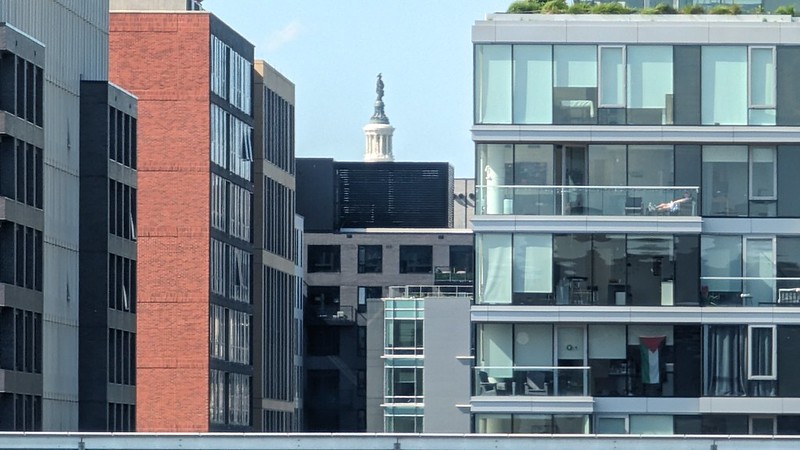
Photo by Tim Brown Ed. Note: If this was you, please email [email protected] so I can put you in touch with OP. “Dear PoPville, Thursday night (April 18th) we were…

For many remote workers, a messy home is distracting.
You’re getting pulled into meetings, and your unread emails keep ticking up. But you can’t focus because pet hair tumbleweeds keep floating across the floor, your desk has a fine layer of dust and you keep your video off in meetings so no one sees the chaos behind you.
It’s no secret a dirty home is distracting and even adds stress to your life. And who has the energy to clean after work? That’s why it’s smart to enlist the help of professionals, like Well-Paid Maids.

Unlock Peace of Mind for Your Family! Join our FREE Estate Planning Webinar for Parents.
🗓️ Date: April 25, 2024
🕗 Time: 8:00 p.m.
Metropolitan Beer Trail Passport
The Metropolitan Beer Trail free passport links 11 of Washington, DC’s most popular local craft breweries and bars. Starting on April 27 – December 31, 2024, Metropolitan Beer Trail passport holders will earn 100 points when checking in at the
DC Day of Archaeology Festival
The annual DC Day of Archaeology Festival gathers archaeologists from Washington, DC, Maryland, and Virginia together to talk about our local history and heritage. Talk to archaeologists in person and learn more about archaeological science and the past of our





